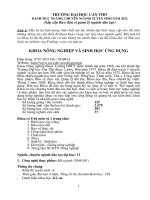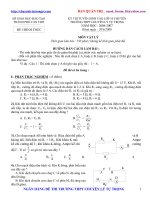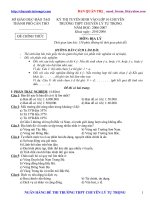A giant crocodile skull from Can Tho, named “dau sau”, represents the largest known saltwater crocodile (Crocodylus porosus) ever reported from Vietnam
Bạn đang xem bản rút gọn của tài liệu. Xem và tải ngay bản đầy đủ của tài liệu tại đây (648.89 KB, 6 trang )
TAP CHI SINH HOC 2019, 41(4): 25–30
DOI: 10.15625/0866-7160/v41n4.14581
A GIANT CROCODILE SKULL FROM CAN THO, NAMED “DAU SAU”,
REPRESENTS THE LARGEST KNOWN SALTWATER CROCODILE
(Crocodylus porosus) EVER REPORTED FROM VIETNAM
Thomas Ziegler1,2, Nguyen Thien Tao3,*, Nguyen Trung Minh3,
Rainier Manalo4, Arvin Diesmos5, Charlie Manolis6
1
AG Zoologischer Garten Köln, Riehler Strasse 173, D-50735 Cologne, Germany
2
Institute of Zoology, University of Cologne, Zülpicher Strasse 47b,
D-50674 Cologne, Germany
3
Vietnam National Museum of Nature, VAST, Vietnam
4
Crocodylus Porosus Philippines Inc., Pag-asa, Kapalong, Davao Del Norte, Philippines
5
Philippine National Museum of Natural History, T.F. Valencia Circle, Rizal Park, T.M.
Kalaw Avenue, Ermita, 1000 Manila, Philippines
6
Wildlife Management International, PO Box 530, Karama, NT 0813, Australia
Received 4 November 2019, accepted 8 December 2019
ABSTRACT
We report on a large crocodile skull recovered from a river bank in August 2010 near Dau Sau
Bridge, in An Binh, Ninh Kieu District, Can Tho Province, in southern Vietnam. As the skull
from Can Tho, named “Dau Sau” herein, is now deposited in the Vietnam National Museum of
Nature, Ha Noi, we reinvestigated the circumstances surrounding its discovery and provide exact
measurements. Skull length (dorsal mid-point) is 70.7 cm. The morphological features confirm it
is from a Saltwater crocodile (Crocodylus porosus), and not a Siamese crocodile (C. siamensis),
which historically also occurred throughout the Mekong Delta of Vietnam. Skull measurements
are compared with those of other large C. porosus skulls for which reliable estimates of total
length are available. We also provide measurements of the prepared skull of “Lolong” (69.8 cm),
a 6.17 m long C. porosus captured in the Philippines in 2011. On the basis of known skull
length:total length ratios the crocodile from Can Tho is estimated to be 6.3-6.8 m long. The skull
of Dau Sau is likely to have been buried for at least 100 years. We discuss the origin of the local
name Dau Sau, which has traditional and cultural significance, and provide historical reports of
crocodiles in the area. Dau Sau is smaller than the largest known C. porosus skull (76 cm), but is
the largest ever reported from Vietnam, and one of the largest C. porosus known.
Keywords: Crocodylidae, Mekong delta, morphology, size, “Lolong”, Philippines.
Citation: Ziegler T., Nguyen Thien Tao, Nguyen Trung Minh, Manalo R., Diesmos A., Manolis C., 2019. A
giant crocodile skull from Can Tho, named “Dau Sau”, represents the largest known saltwater crocodile
(Crocodylus porosus) ever reported from Vietnam. Tap chi Sinh hoc (Journal of Biology), 41(4): 25–30.
/>*Corresponding author email:
©2019 Vietnam Academy of Science and Technology (VAST)
25
Ziegler et al.
INTRODUCTION
Extant crocodilian species show a wide
range of maximum total lengths (TL), and the
Saltwater crocodile (Crocodylus porosus) is
considered one of the largest, with males
exceeding 6 m TL. However, precise data on
exceptionally large crocodile skulls and the
individuals from which they were derived
(TL, origin, date of acquisition) are usually
incomplete (Fukuda et al., 2018).
Saltwater crocodiles have one of the
widest geographic distributions of any
crocodilian, ranging from eastern India,
through Southeast Asia and the Pacific
islands, to Australia in the south. In Vietnam,
C. porosus is considered to have become
extinct long ago, through overexploitation for
food and skin, and extensive habitat
degradation (Webb et al., 2010). The endemic
Siamese crocodile (C. siamensis) had suffered
a similar fate, but in 2001–2004 a
reintroduced population was established in
Cat Tien National Park (Polet 2002; Murphy
et al., 2004). Few C. porosus are currently
held within the 800+ crocodile farms in
Vietnam, and hybridization between C.
porosus, C. siamensis and the exotic Cuban
crocodile (C. rhombifer) is likely within the
captive population (Jelden 2008).
On 31 August 2010, a large crocodile
skull was dug up during excavations at a river
bank near Dau Sau Bridge (10o01’247’’N;
105o75’377’’E), in An Binh, Ninh Kieu
District, Can Tho Province, in southern
Vietnam. The skull was pulled out at 6 pm by
Mr. Tran Van Ut.
Local newspapers reported the skull as
being some 90 cm long, surpassing known
size records for C. porosus (76 cm), and
even the longest known recent crocodilian
skull in existence (84 cm) - that of a
Tomistoma (Tomistoma schlegelii) held in
the British Museum of Natural History
(Whitaker and Whitaker 2008). The articles
also provided estimates of other attributes,
such as age (100 years), length (5–6 m), and
body weight (400 kg).
26
Here, we provide accurate measurements
of the Can Tho skull, confirm its identity and
derive estimates of the TL of the crocodile
from which it came. The skull is now
deposited in the Vietnam National Museum of
Nature (VNMN) in Ha Noi.
MATERIALS AND METHODS
The crocodile skull from Can Tho was
examined by T. Ziegler at VNMN and the
following measurements (after Webb and
Messel 1978) were taken using a metal
measuring tape. Total skull length was
measured to the nearest mm, and all other
measurements to the nearest 0.5 cm.
1. Total skull length (TSL): Tip of snout
to the median hind edge of the cranial
platform. Due to damage to the left
premaxillary bone, the “tip” was estimated.
2. Maximum skull width: Measured at
the widest point.
3. Cranial platform width: Maximum
width of the cranial platform.
4. Cranial platform midpoint width:
Narrowest width of the cranial platform
(where it is usually concave).
5. Snout-eye length: Tip of snout to
anterior edge of orbit.
6. Snout length: Tip of snout to level of
anterior edge of orbit, measured along midline
of snout.
7. Interocular width: Narrowest distance
between orbits.
For comparison, we included the
measurements of the skull of ‘Lolong’ (see
table 1), a giant Saltwater crocodile captured
in 2011 from Magsagangsang Creek in
Agusan Marsh, Agusan del Sur Province, in
the southern Island of Mindanao, the
Philippines. The skull is at the National
Museum of the Philippines in Butuan City,
Mindanao, and was examined and measured
by R. Manalo.
RESULTS
The skull from Can Tho, named Dau Sau
herein, is in relatively good condition, with the
A giant crocodile skull
only significant damage being the left
premaxillary bone of the snout and the right
pterygoid (Fig. 1). The two elongate ridges
running from the orbits down the upper part of
the snout are characteristic of C. porosus. In C.
siamensis the squamosals form a pronounced
bony ridge with another ridge (crest) that
extends anteriorly between the orbits (Platt et
al., 2018). This feature is absent in the skull
from Can Tho. In addition, the size of the skull
is from a crocodile that well exceeds the TL of
C. siamensis, with a maximum TL around 4.0
m (Platt et al., 2018). The skull measurements
of Dau Sau are compared with other known
large C. porosus skulls (table 1) for which
reliable estimates of TL are available.
Table 1. Measurements (cm) of Dau Sau, the skull from Can Tho, relative to other large
Crocodylus porosus skulls
Total Skull
Length
Total Head
Length
Maximum
Skull Width
Cranial
Platform
Width
Cranial
Platform
Midpoint
Width
Snout-eye
Length
Snout
Length
Interocular
Width (cm)
Total
Length
Dau
Sau
Ziegler
et al.,
(this
study)
Old
Charlie
Webb and
Messel
(1978)
Dhamara
Kar
(2006)
Stuart
Manolis
(2006)
Lolong
(live
specimen)
Britton et
al., (2012)
Lolong
(skull)
Ziegler et
al., (this
study)
Edgar
Fukuda
et al.,
(2018)
Giryu
Fukuda
et al.,
(2018)
70.7
66.6
68
72.8
-
69.8
70.1
70.6
-
-
-
-
70.0
-
-
-
42.0
48.0
40
45.8
45.0
43.7
52.0
-
22.5
23.5
18
23.0
22.8
22.8
240
205
19.0
18.9
15
19.4
-
-
-
-
51.0
44.3
35
50.0
49.6
-
-
-
49.5
-
-
-
-
49.2
-
-
8.0
7.5
8
7.1
8.4
8.3
8.0
6.7
?
615
608
670
617
-
670
-
The year in which Dau Sau died and its
remains were longed in sediments is
unknown. Local residents indicated that
crocodiles had not been seen in the region for
decades, but the oldest residents (ca. 80 years
old) reported
anecdotes
from their
grandparents, about a very large crocodile
occurring in that river historically. It is thus
considered likely that the skull had been
buried underground for over 100 years.
DISCUSSION
The name “Dau Sau” has many meanings
in the local vernacular. In reference to a
locality, Dau Sau means “crocodile head”, and
there exists a number of places named as
such, including Dau Sau channel, Dau Sau
estuary, or Dau Sau bridge. Traditional beliefs
(e.g., Can Tho Online 2010) refer to Dau Sau
as “a huge land mass inhabited by few people
and where both sides of the river are
deserted.” It is unknown from where the name
“Dau Sau” actually originated, but there is a
folk tale about an area of Cai Rang (formerly
belonged to Can Tho), that had many
crocodiles. According to the folklore, one day,
during a traditional wedding ceremony
involving boats on this river, a large crocodile
27
Ziegler et al.
whipped its tail, flipped a boat, and took the
bride away. The groom, anguished and
furious, gathered many strong young people
to capture the crocodile. After catching the
crocodile, the groom cut it into pieces and
threw them into the river to satisfy his anger.
Wherever a piece of the crocodile was washed
up, people named that part of the channel
accordingly. The area where the skin was
found was named Cái Da (skin), the area
where the teeth were found was called Cái
Răng (teeth), and the area where the head was
found was called Đầu Sấu (crocodile head).
two men” are found. His story continues that
in the early years of the 20th century, there
was a group of Chà people who were famous
for hunting crocodiles. They helped to spear
and kill a crocodile “as large as a five-plankboat” - longer than 6 meters - in the Cai Rang
River. Therefore, after capturing the
crocodile, everyone was cheerful, gathered
around to divide up the meat. Mr. Ut also
reported that up until around 1940 he still saw
people butchering crocodiles upstream of the
estuary. Crocodile meat was transported from
Nam Vang and An Giang to Can Tho by boat
(e.g., Can Tho Online 2010). At that point,
this area had already been called Dau Sau
estuary/Dau Sau channel. In area 1 (An Bình
ward nowadays) there is still an ancient
temple named ông Vàm Dau Sau [translated
as sir Dau Sau estuary; people usually refer to
big animals respectfully as ông (which means
sir or grandfather)].
Figure 1. Dau Sau , the crocodile skull from
Can Tho, with measuring tape from above
(top) and below (bottom). Photo T. Ziegler
The man who discovered the crocodile
skull did so when he was 86 years old. His
family had worked as net fishermen at Dau
Sau estuary for generations. His grandfather,
who passed away in 1942, and his father, who
passed away in 1965, told a story about a
remote part of Dau Sau channel where big fish
abounds, and where crocodiles “as large as
28
Figure 2. Two elongate ridges running from
the orbits down the upper part of the snout are
a characteristic of C. porosus and well
discernible in Dau Sau, the crocodile skull
from Can Tho. Photo T. Ziegler
A giant crocodile skull
Figure 4. The Saltwater crocodile
(Crocodylus porosus) Lolong (6.17 m TL) in
the public exhibit of the National Museum of
the Philippines in Manila; for size
comparisons see egrets at the right and adult
visitors standing behind and observing the
giant crocodile. Photo T. Ziegler
involving C. rhombifer can be rejected,
because C. rhombifer were first imported in
the 1980’s. It also clearly predates crocodile
farming in South-East Asia (from 1950’s) and
Vietnam specifically (1980’s),
where
hybridization between C. siamensis and C.
porosus is commonplace in captive animals. It
seems unlikely that it could involve natural
hybridisation in the wild with C. siamensis,
but the possibility cannot be rejected as
pending molecular analysis currently is
underway.
Total length in C. porosus less than 5 m
can be reliably estimated from head length
(HL) alone, but the relationship between these
attributes in large (> 5 m TL) C. porosus is
more complex (Webb and Messel 1978).
Fukuda et al. (2013) recommended a TL:HL
ratio of 8.0 for > 5 m long C. porosus, and
although this may be suitable for estimating
size during population surveys, it does not
take into account the variation that can occur
among
individuals.
Definitive
TL
measurements are available for few large C.
porosus skulls, but for five individuals
reliable TL:HL ratios can be derived: 8.8 for
Lolong (6.17 m); and, after adjusting for
tissue loss (4%; Webb and Messel 1978)
between HL and TSL, 9.2 for Old Charlie
from Australia (6.15 m) and Edgar from Java,
Indonesia (6.7 m), 8.8 for Stuart from
Australia (6.7 m), and 8.5 for Dhamara from
India (6.04 m) (table 1). On the basis of these
size ratios, the crocodile from Can Tho is
estimated to be 6.3–6.8 m long.
Although slightly smaller than the largest
known C. porosus skull (76 cm), from an
individual killed in the early 1800s in
Cambodia, and now held in the Natural
History Museum, Paris (Whitaker and
Whitaker 2008), Dau Sau, the skull from Can
Tho, with a length of 70.7 cm certainly
represents the largest known C. porosus ever
reported from Vietnam and one of the largest
C. porosus skulls recorded from anywhere in
the world.
The skull is totally consistent with C.
porosus. The possibility that it is a hybrid
Acknowledgements: We thank Anna Rauhaus
(Cologne Zoo, Germany), Jake Wilson B.
Binaday (Crocodylus Porosus Philippines,
Figure 3. Held by one of the authors (Nguyen
Thien Tao), the huge dimension of Dau Sau
becomes apparent. Photo T. Ziegler
29
Ziegler et al.
Inc., Philippines), Grahame Webb (Darwin,
Australia), Nguyen Vu Khoi (Wildlife at Risk,
Vietnam), Nguyen Quang Truong (Institute of
Ecology and Biological Resources, Vietnam)
for providing information and various
assistance. Thanks also to T. Pagel and C.
Landsberg (Cologne Zoo, Germany) for their
support of research and conservation activities
in Vietnam. Cologne Zoo is partner of the
World Association of Zoos and Aquariums
(WAZA): Conservation Projects 07011,
07012, 10007 (Herpetodiversity Research,
Amphibian and Reptilian Breeding and
Rescue Stations, Siamese crocodile research
and conservation). This research was partly
supported by the Project BSTMV.8/16-19 to
T. T. Nguyen.
REFERENCES
Britton A. R. C., Whitaker R., Whitaker N.,
2012. Here be a dragon: Exceptional size
in a saltwater crocodile (Crocodylus
porosus)
from
the
Philippines.
Herpetological Review, 43: 541–546.
Can Tho Online, 2010. Văn hoá - Giải trí. Một
vài suy nghĩ về địa danh Dau Sau
/>accessed:
30/10/2010.
Fukuda Y., Saalfeld K., Lindner G., Nichols
T., 2013. Estimation of total length from
head length of saltwater crocodiles
(Crocodylus porosus) in the Northern
Territory,
Australia.
Journal
of
Herpetology, 47: 34–40.
Fukuda Y., How C. B., Seah B., Yang S.,
Pocklington K., Peng L. K., 2018.
Historical, exceptionally large skulls of
saltwater crocodiles discovered at the Lee
Kong Chian Natural History Museum in
Singapore. The Raffles Bulletin of
Zoology, 66: 810–813.
Kar S., 2006a. Record of a large saltwater
crocodile from Orissa, India. Crocodile
Specialist Group Newsletter, 25(3): 27.
30
Kar S., 2006b. World’s largest crocodile
skull? Crocodile Specialist Group
Newsletter, 25(4): 21–22.
Manolis C., 2006. Record of a large saltwater
crocodile from the Northern Territory,
Australia. Crocodile Specialist Group
Newsletter, 25(3): 27–28.
Murphy D. J., Thuc P. D., Nguyen T. L.,
2004. The Siamese Crocodile Reestablishment Programme in Cat Tien
National Park, Vietnam, 1999–2004.
Technical Report No. 48, Cat Tien
National Park Conservation Project.
Platt S.G., McCaskill L., Rainwater T. R.,
Temsiripong Y., As-singkily M., Simpson,
B. K. and Bezuijen M. R., 2018. Siamese
Crocodile Crocodylus siamensis. In
Crocodiles.
Status
Survey
and
Conservation Action Plan. Fourth Edition,
ed. by S. C. Manolis and C. Stevenson.
Crocodile Specialist Group: Darwin.
Polet G., 2002. Crocodylus siamensis reintroduced in Cat Tien National Park.
Crocodile Specialist Group Newsletter,
21: 9–10.
Whitaker R., Whitaker N., 2008. Who’s got
the biggest? Crocodile Specialist Group
Newsletter, 27(4): 26–30.
Webb G. J. W., Manolis S.C. Brien M. L.,
2010. Saltwater Crocodile Crocodylus
porosus. Pp. 99–113 in Crocodiles. Status
Survey and Conservation Action Plan.
Third Edition, ed. by S. C. Manolis and C.
Stevenson. Crocodile Specialist Group:
Darwin.
Webb G. J. W. Messel H., 1978.
Morphometric analysis of Crocodylus
porosus from the north coast of Arnhem
Land, northern Australia. Australian
Journal of Zoology, 26: 1–27.









